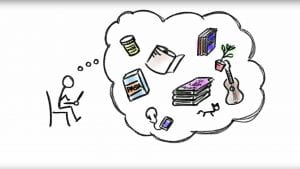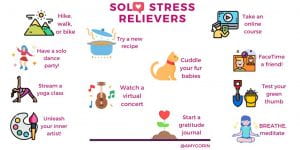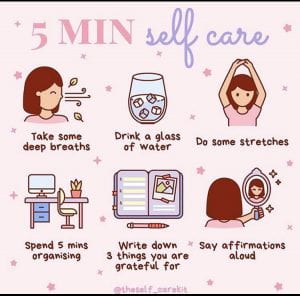Hello everybody! Let’s talk COVID-19 x Social Media. Here I will be discussing social media usage during COVID-19 and what I noticed when I cut down on my social media usage for a few days. As COVID-19 continues, it has become obvious that a lot of us are spending more time on our phones and laptops (even TVs) than we used to before. Some of us are perfectly fine with this, and it is working well as a means of keeping in touch and up to date, and others are frustrated with how much time is currently spent on the screen. I fall into the latter category. Because some of my screen time (like work and school initiatives) is non-variable, I decided to change the one aspect of it that is variable for me: my usage for personal purposes, a lot of which involves social media. Keep reading for my personal tips around why cutting down on usage can be helpful as well as how you might go about approaching this!
(Keep in mind, this is not for everybody right now – many of us are far away from loved ones and find social media to be a great tool in helping keep us connected. Many of us tend to use social media as a news source. And for some of us, social media usage and technology usage is simply a means of coping right now – and that is perfectly okay if it’s working for you. If this is the case for you, maybe sometime in the future would be more feasible for a cleanse like this. Or maybe you do a half cleanse now… still use certain platforms but not others, or just use platforms less than you usually would. OR maybe now is the perfect time for a cleanse because you’re sick of all of the screen time. Do what is best for you personally! The following are some ideas that worked for me.)
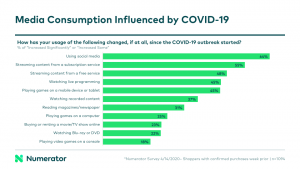
If you are currently a student like me, not only are you now taking four (or more) online classes, you might also be doing remote work for a job as well. For me, the combination of four different online classes, a remote job in which I engage in 5/7 days of the week, the online search for a job for after graduation, and any personal technology usage outside of these things really adds up! It feels as though my whole life could be lived on the screen right now if I let it get to that place. Which is why I wanted to write this post… and why I took a cleanse from social media for a few days.

For my cleanse, I decided to remove Instagram, Twitter, Facebook, Snapchat, and TikTok (we all know how encaptivating this one is nowadays) from my phone. For me, it had to be all of these apps, as I wanted to do a full cleanse, and these are the social media apps that I gravitate towards the most on a daily (sometimes even hourly – oops) basis. Initially, I kept the apps fully deleted, but one day in I decided to redownload them, simply turn off all notifications and badges for each of them, and keep them in a folder on the last ‘page’ of my phone where I wouldn’t be as tempted to click on them. The only reason I redownloaded the apps was so that I could check in once or twice a day to stay connected, but still remain mostly off of these apps. I made this decision because I realized that right now – during COVID – it is extremely hard to be completely disconnected from social media as a lot of our interaction with loved ones occurs over social media at this moment in time. Basically, I noticed that I did not want to be completely disconnected from this outlet, as there are many positive aspects to it as well, so I adjusted my cleanse. A big tip of mine: Feel free to adjust at any time if you need to! This is all about what serves YOU best.
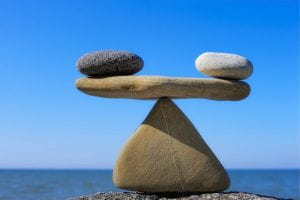
Being flexible in this way is important, in my mind, as it leaves more room for ‘process improvement,’ so to speak. I am also a big proponent of the idea of balance in life, so having no access at all to the apps felt a bit extreme to me. Keeping my apps on my phone – just more tucked away – also allowed me to practice having self-control, as I still had access and was forced to make the conscious decision to avoid engaging. Knowing the apps were there in the back of my phone was tempting at some points in time, but I knew I needed to hold out and stay true to my commitment to take a break because of all of the positive aspects that were coming with it. And each time I chose to live in the moment versus go on my social media apps, I felt accomplished.
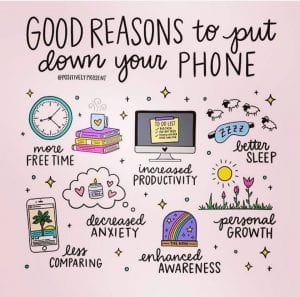
Let’s now talk about what I noticed by doing this cleanse. And afterwards I’ll provide some tips for those who are interested in trying this as well. Remember, this is not an exhaustive list – there are so many benefits to decreasing screen time/time on social media, and they show differently for everyone.
- One of the first things that I noticed was an overall increase in wellbeing. By this I mean that I simply just felt better – overall! There could be many reasons as to why this was the case, but I think the things that I am about to mention next were a big part of it.
- One of these things was that I noticed I felt (and probably was) a lot more in the moment. I really felt present! I felt engaged in life and in interactions with others and myself. I’d go as far as to say that going off of my social media actually increased the mindfulness that I had moving through my days. And we know that there are so many different benefits to mindfulness! The biggest benefit that I see in mindfulness is that you are literally taking back time that is otherwise lost to being the opposite of mindful about life. When you are mindful, you are fully living in every moment and taking it all in completely.
- Another interesting thing that I noticed was that I started choosing to partake in activities that I might not have otherwise gravitated towards as much before taking a break from social media. I actually felt myself getting more creative in my pursuit of entertainment/stimulation. For instance, I started playing more board games and card games with my family. And I started using the app Duolingo to re-teach myself Spanish. It wasn’t that I wasn’t interested in doing these types of activities before, but it was just so easy to hop on my phone (social media) that I often times wouldn’t even consider trying something else. In this way, I believe that the cleanse actually helped me to expand my mind in a way and increase my creativity as it relates to choosing new and fun activities to engage in. Now, even though I am not on a hiatus from social media anymore, I still choose to participate in these activities that I picked up during my break, and I’m so happy that I have this newfound appreciation for them.
- Another interesting thing that I noticed had to do with the amount of time I felt I had in a day. Time is something that many of us seem to have a bit of a love/hate relationship with. Many of us feel that in this fast-paced day and age we live in we never have enough time to truly live! I think that often times we genuinely believe we have zero free time in any given day – and for some of us with super busy schedules this might be true at times – but think about the number that is your screen time (this number can usually be found in the settings app of a smartphone) and how much time this takes out of a 24-hour day. Say your screen time each day is 4 hours (out of 24). That is 1/6th of your day lost to staring at a screen versus participating in life outside of the screen. Imagine if you even just cut that number in half and had an extra hour or two to do what you wanted with each day – that’d be so much more time to actually live!
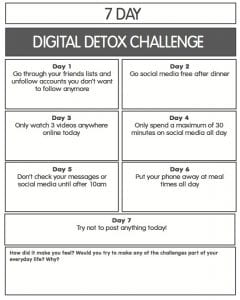
Are you looking to do a cleanse yourself but simply don’t know where to get started? Here are some tips that I found to be helpful in staying true to the commitment to a cleanse:
- One thing that I found helpful – this I mentioned earlier too – was to put the social media apps in a folder on the last ‘page’ of my phone so that they weren’t as easily accessible; they were ‘out of sight out of mind’ so to speak.
- Turning off notifications and badges was also so helpful! I cannot emphasize this enough. This made all the difference for me. In the past, it was so easy to feel tempted to go on social media anytime and all the time because there were constantly notifications reminding me that something new was happening. Those little red badges would constantly tell me that I had a new message on Instagram or picture to see on Snapchat. By turning off my notifications and badges I was able to cut down on my usage a lot as I didn’t see everything constantly popping up on my lock screen and, subsequently, wasn’t always automatically checking it – it became a conscious decision to go on an app, and I got to see any updates when I made this decision. I realized that a lot of these updates were not nearly as ‘time sensitive’ as I had labeled them as before and that a lot of them could wait until the end of the day.
- A caveat here: I think that often times our social media usage can become quite “autopiloted” versus conscious, and so one easy way to cut down on social media usage is to simply become more aware of our usage – this means both being aware of when you are and aren’t going on as well as being aware of whether or not you’re doing so consciously. For some, keeping a journal might even be of value! You could simply log whenever you are going on, for how long, why you decided to go on, and what you were doing in order to become more mindful of your usage (if anything).
- If you feel comfortable doing so, making an announcement online to others that you will be cutting off/down your usage can be really helpful – this serves as an accountability check. This could be as simple as making an Instagram story (or any other equivalent) that says something along the lines of, “Taking a break from social media for a few days [or weeks if you choose] – if you need to contact me, shoot me a text instead.” Putting out a message like this can also save you from the stressful thought that perhaps others will think you’re ignoring them, or the stress that you might miss an important message from a loved one. (You can also just reach out to the individuals who would be most likely to contact you and just let them know to reach out via a phone call or text message instead.)
- Making an announcement to friends and family that you tend to see on a regular basis can also be quite helpful (& is something you could do instead of making one online if you don’t feel as comfortable doing that) – these people can help check you if they see you spending a lot of time on your phone!
Well, that is all I have for now. I hope that at least one of these tips and tricks rings true with you! If now is a time that you would like to do a cleanse as well – just remember, we all have different needs… do what’s right for you and adjust when needed! Balance in life is important.
xoxo,
Lauren at HPW







